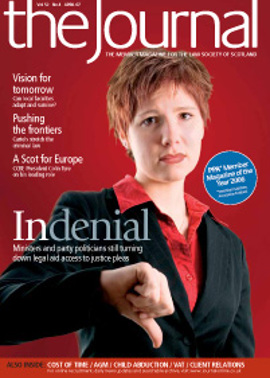Profit, team by team

Last month’s article emphasised the importance of financial structure in determining profitability. This was in the context of static profits in 2006, and a fall for some smaller firms. It considered two important aspects – gearing and fees per profit-sharing partner. This article considers two further key aspects of structure:
- salaries relative to fees; and
- non-salary overheads – relative to fees.
Combination figure
It is often quite difficult to interpret the performance of a firm of solicitors. In part this is because the profits the partners receive reflect their reward for contributions that in a corporate environment would be rewarded separately:
- the work they put into the firm as a lawyer or manager – salary;
- the capital they provide to help finance the firm – interest;
- the offices they own that the firm may occupy free of charge – rent;
- their risk as an owner – profit.
A partner’s profit share can, depending on the circumstances, in effect combine all of these – a salary, interest on capital, rent and a profit over and above these that justifies the risk of running the business.
The annual Cost of Time Survey makes allowance for each of these factors. It includes a notional salary for each profit-sharing partner of £66,000 – the average of the median net income figures from the previous two years’ surveys – and makes allowance for a notional interest charge, and also builds in a notional rent if the partners own the offices.
Close relationship
Taking the 2-4 partner firms as an example, chart 1 indicates that for the most profitable firms non-salary overheads were less than 24% of fee income – compared to 35% for the least profitable. Chart 2 indicates that amongst the same most profitable firms, salaries, including the notional salary for the profit-sharing partners, were under 50% of fees. Amongst the least profitable firms, salaries were more than 78% of fees – an amazing difference. Twenty eight per cent of any firm’s fee income will be a large amount.
Although firms have traditionally focused much attention on keeping overheads under control generally, time spent examining the relationship between salaries (including the notional salary for the profit-sharing partners) and fees is more productive. Central salaries – cashroom, reception, etc – are typically 10% of fees, so for the 2-4 partner firms in chart 2 it is likely that departmental salaries – the fee earners and secretarial and other support staff actually based in the departments – would have been approximately 40% of fees. At departmental level they would have been achieving a 60% gross profit margin.
Your own cost comparisons
Table 1 opposite illustrates how this type of analysis could be used to assess performance within a firm. It is assumed the firm is departmentalised. The fees of each fee earner have been allocated to the appropriate department together with their salary costs and those of their support staff. Department-specific overheads have also been included, but general overheads and central salaries have not. These have been excluded as they are beyond the control of the department.
The table indicates the relative profitability of the four departments, and is the starting point for a potentially highly productive discussion. Not a witch hunt, but a constructive conversation that might touch on staffing levels, the level at which work is done, working methods, use of IT… You could allocate general overheads but should only do so to emphasise the point. For example, if the £343,000 general overheads and central salaries had been allocated pro rata to the 10 fee earners, commercial would have made a loss. You may need to do this calculation in order to make the partner take notice, but beware getting bogged down in arguments about allocation of fixed costs. The real issue is the profitability of commercial, and perhaps also court and executries, not how fixed cost has been allocated.
These two benchmarks – in particular the salaries ratio – together with the departmental analysis illustrated above have been key to many firms’ efforts to improve profitability. Try doing this analysis for your accounts for, say, the last year, or the last quarter. Then do it at the end of the next quarter. Start to get a feel for the figures. Let the fee earners in your departments see these figures. By making them more aware of the figures, they can be more involved and more committed. Their attention becomes more focused on profitability rather than just fees.
All participating firms receive a free copy of “The 2006 Survey of Law Firms in Scotland”, the detailed report upon which this article is based. They also receive a free confidential individual report. Other firms can obtain a copy of the full report which contains a wide range of useful statistics and performance indicators, from Lisa Hamilton at the Society on 0131 476 8164 (mail to: lisahamilton@lawscot.org.uk).
In April the President will be writing to all firms inviting them to participate in the 2007 survey. Participation is free and this year carries a three hour CPD credit as well as an individual report on cost rates in the firm and a copy of the survey report. In recent years there has also been a prize draw. Last year the £700 prize was won by Charles Sharkey. The Society is again grateful to Alex Quinn and Partners for sponsoring the prize in 2006.
Andrew Otterburn is a management consultant and for many years has run practice management seminars on behalf of the Society. He has helped in the development of the Cost of Time Survey since 1999, working initially with Professor John McCutcheon and now with Dr John Pollock. His book, Profitability and Law Firm Management, is published by the Law Society in London. The second edition is published this autumn.
Dr John Pollock, a consulting actuary, has been responsible for the administration and statistical aspects of the Cost of Time survey since 2002. John is well known to personal injury, employment and family law solicitors in Scotland through his expert witness work at Pollock & Galbraith Consulting Actuaries.
Please see downloadable PDF for charts and tables.
In this issue
- The bigger picture
- Citizen justice
- Purely rhetoric?
- Purely rhetoric? (1)
- Profit, team by team
- Bring them home
- Bring them home (1)
- Local roots
- Wanted! (for conspiracy)
- One voice
- AGM report
- Dealing positively with client concerns
- Block fees: the story behind the changes
- Think before you charge
- For the high jump
- Jury questions
- Put to the test
- Yet another expense
- Planning with people
- Lifting the lid
- Website reviews
- Book reviews
- Home is where the heart is
- PSG - new certificate of title
- SEPA: apply online and save
- SEPA: apply online and save (1)






